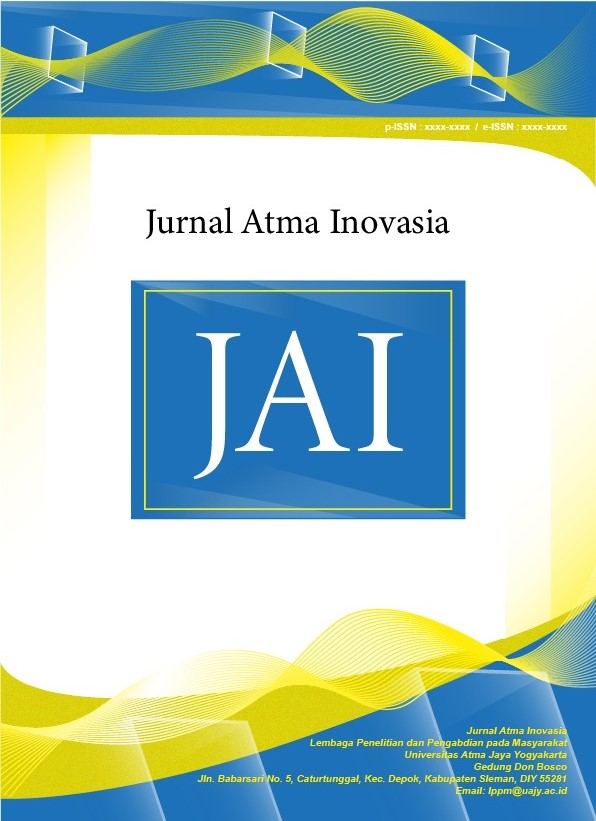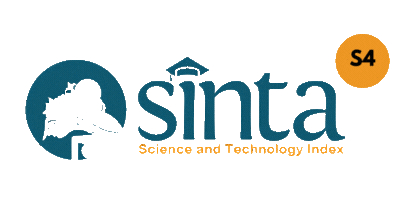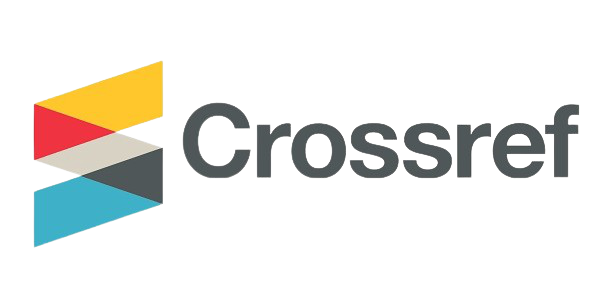Pelatihan Pengolahan Tanaman Obat Keluarga (TOGA) Menjadi Kosmetika di Wilayah Kapanewon Sanden
DOI:
https://doi.org/10.24002/jai.v5i5.10365Keywords:
lulur, kesehatan kulit, kosmetika, TOGAAbstract
Kosmetika adalah sediaan yang dimaksudkan untuk digunakan pada bagian luar tubuh manusia dengan tujuan antara lain untuk membersihkan tubuh. Salah satu produk kosmetika yang diminati adalah kosmetika yang mengandung bahan rempah, yang banyak ditanam oleh masyarakat sebagai Tanaman Obat Keluarga (TOGA). Tujuan akhir kegiatan pengabdian kepada masyarakat ini adalah meningkatkan pengetahuan tentang manfaat TOGA khususnya untuk kesehatan kulit, serta meningkatkan keterampilan pengolahan TOGA menjadi sediaan kosmetika untuk 90 orang kader Asuhan Mandiri TOGA di wilayah Kapanewon Sanden. Kegiatan pengabdian masyarakat dilaksanakan dengan penyampaian materi mengenai keluhan kulit dan keamanan lulur bahan alam, bentuk sediaan kosmetika, bahan alam yang dapat digunakan untuk kesehatan gigi dan mulut, pembuatan lulur dan sabun dari TOGA, kemudian dilanjutkan dengan praktek pelatihan pengolahan TOGA menjadi lulur. Lulur yang diproduksi oleh kader dan masyarakat telah digunakan oleh masyarakat dan keluarganya
References
[1] BPOM RI, “Peraturan Badan Pengawas Obat dan Makanan RI Nomor 17 Tahun 2022 Tentang Persyaratan Teknis Bahan Kosmetika,” BPOM RI, no. 702. pp. 1–337, 2022.
[2] A. M. Alnuqaydan, “The dark side of beauty: An in-depth analysis of the health hazards and toxicological impact of synthetic cosmetics and personal care products,” Front. public Heal., vol. 12, no. August, p. 1439027, 2024, doi: 10.3389/fpubh.2024.1439027.
[3] Y. H. Choi, S. E. Kim, and K. H. Lee, “Changes in consumers’ awareness and interest in cosmetic products during the pandemic,” Fash. Text., vol. 9, no. 1, pp. 1–19, 2022, doi: 10.1186/s40691-021-00271-8.
[4] E. Wargala, M. Sławska, A. Zalewska, and M. Toporowska, “Health fffects of dyes, minerals, and vitamins used in cosmetics,” Women, vol. 1, no. 4, pp. 223–237, 2021, doi: 10.3390/women1040020.
[5] N. Amberg and C. Fogarassy, “Green consumer behaviour in the cosmetics market,” Resources, vol. 8, no. 3, pp. 1–19, 2019.
[6] M. I. Irfany, Y. Khairunnisa, and M. Tieman, “Factors influencing muslim generation Z consumers’ purchase intention of environmentally friendly halal cosmetic products,” J. Islam. Mark., vol. 15, no. 1, pp. 221–243, 2024, doi: 10.1108/JIMA-07-2022-0202.
[7] S. Hutomo, Y. I. Suryanto, and N. Kurniawati, “Pembentukan kelompok asuhan mandiri tanaman obat keluarga (TOGA) dan akupresur di Kecamatan Sanden, Kabupaten Bantul,” Patria, vol. 2, no. 1, p. 1, 2020, doi: 10.24167/patria.v2i1.2569.
[8] S. Hutomo, D. C. A. Nugroho, and N. Kurniawati, “Pembentukan dan pembinaan paguyuban orangtua peduli stunting di dusun Wonoroto, Gadingsari, Sanden, Bantul,” Pros. SENDIMAS, vol. 5, no. 1, pp. 47–50, 2020.
[9] S. Hutomo, C. M. Sooai, M. S. Merry, H. D. Kristianto, and N. Kurniawati, “Pembentukan kader remaja new normal dusun Mayungan II dan Karanganyar, Sanden, Bantul,” Sendimas 2021 - Semin. Nas. Pengabdi. Kpd. Masy., vol. 6, no. 1, pp. 293–296, 2021, doi: 10.21460/sendimasvi2021.v6i1.61.
[10] Y. I. Suryanto, S. Hutomo, C. M. Sooai, and N. Kurniawati, “Pembentukan kader juru pemantau stroke (jumantroke) di kelurahan Murtigading dan Srigading, Sanden, Bantul Yogyakarta,” Pros. SENDIMAS, vol. 8, no. 1, pp. 207–213, 2023.
[11] BPOM RI, “Peraturan Badan Pengawas Obat Dan Makanan Nomor 8 Tahun 2021 Tentang Bentuk Dan Jenis Sediaan Kosmetika Tertentu Yang Dapat Diproduksi Oleh Industri Kosmetika Yang Memiliki Sertifikat Produksi Kosmetika Golongan B,” BPOM RI. p. 10, 2021, [Online]. Available: https://jdih.pom.go.id/download/product/1235/8/2021.
[12] E. Ayaz, C. Gökbulut, H. Coşkun, A. Türker, Ş. Özsoy, and K. Ceylan, “Evaluation of the anthelmintic activity of pumpkin seeds (Cucurbita maxima) in mice naturally infected with Aspiculuris tetraptera,” J. Pharmacogn. Phyther., vol. 7, no. 9, pp. 189–193, 2015, doi: 10.5897/JPP2015.0341.
[13] M. Grzybek et al., “Evaluation of anthelmintic activity and composition of pumpkin (Cucurbita pepo L.) seed extracts—in vitro and in vivo studies,” Int. J. Mol. Sci., vol. 17, no. 9, pp. 1–21, 2016, doi: 10.3390/ijms17091456.
[14] A. Cortés, M. García-Ferrús, J. Sotillo, J. Guillermo Esteban, R. Toledo, and C. Muñoz-Antolí, “Effects of dietary intake of garlic on intestinal trematodes,” Parasitol. Res., vol. 116, no. 8, pp. 2119–2129, 2017, doi: 10.1007/s00436-017-5511-1.
[15] Y.-H. Ma, M.-H. Wu, L.-Y. Chung, C.-M. Yen, Y.-S. Juan, and R.-J. Lin, “Cestocidal activities of bioactive garlic compounds against Hymenolepis nana,” Acta Trop., vol. 235, no. November, p. 106580, 2022, doi: 10.1016/j.actatropica.2022.106580.
[16] J. de J. Martínez-González et al., “Evaluating the effect of curcumin on the metacestode of Taenia crassiceps,” Exp. Parasitol., vol. 239, no. August, p. 108319, 2022, doi: 10.1016/j.exppara.2022.108319.
[17] M. H. Herawati and N. Husin, “Berbagai jenis tumbuhan yang berkhasiat sebagai obat kecacingan,” Media Litbang Kesehatan, 2000.
[18] A. D. Khan and M. Alam, “Cosmetics and their associated adverse effects: A review,” J. Appl. Pharm. Sci. Res., vol. 2, no. 1, pp. 1–6, 2019.
[19] V. Sakkaravarthi, “History of soap,” Cosmoderma, vol. 2, no. 133, p. 133, 2022, doi: 10.25259/csdm_152_2022.
[20] S. Panigrahi and W. Feuer, “Cosmeceutical cleansers,” in Procedures in Cosmetic Dermatology: Cosmeceuticals, 4th ed., J. S. Dover, Ed. Philadelphia: Elsevier, 2025, pp. 248–269.
[21] F. Maulidina, R. Risandiansyah, and A. Yahya, “Efek antibakteri dan antibiofilm ekstrak kayu siwak (Salvadora persica) terhadap Streptococcus mutans,” pp. 1–10, 2022.
[22] H. H. Sadiah, A. I. Cahyadi, and S. Windria, “Kajian daun sirih hijau (Piper betle L) sebagai antibakteri,” J. Sain Vet., vol. 40, no. 2, p. 128, 2022, doi: 10.22146/jsv.58745.
[23] Maspiyah, Suhartiningsih, and N. Kusniah, “The physical properties of by-product proportion in rice flour-based facial scrub,” vol. 473, no. Icss, pp. 659–666, 2020, doi: 10.2991/assehr.k.201014.143.
[24] D. Canistro et al., “The pharmacological basis of the curcumin nutraceutical uses: An update,” Pharmadvances, vol. 03, no. 02, p. 421, 2021, doi: 10.36118/pharmadvances.2021.06.
[25] F. Colombo and M. Milani, “The role of an Aloe vera and antimicrobial peptide-based skin cleanser on microbiome balance in acne vulgaris: A prospective , proof of concept , open label trial,” J. Clin. Exp. Dermatol. Res., vol. 14, no. 2, pp. 1–4, 2023, doi: 10.35841/2155-9554.23.14.632.Citation.
[26] J. Zhu, Y. Zheng, and Y. Ge, “Study on the application of Aloe vera in cosmetology and clinical treatment of skin diseases,” J. Holist. Integr. Pharm., vol. 5, no. 4, pp. 299–304, 2024, doi: 10.1016/j.jhip.2024.11.006.
[27] B. S. Latumahina et al., “Pemberdayaan masyarakat melalui program KKN society 5.0 di Desa Planjan Kecamatan Saptosari Kabupaten Gunungkidul,” J. Atma Inovasia, vol. 1, no. 2, pp. 138–146, 2021, doi: 10.24002/jai.v1i2.3895.
[28] L. Agustina, Santhyami, E. P. A. N. Tyas, M. G. Wicaksono, and M. R. Andika, “Utilization of family medicinal plants for health in Ngasem village,” Community Empower., vol. 8, no. 6, pp. 787–792, 2023, doi: 10.31603/ce.8219.
[29] R. P. Matantya et al., “Potensi Desa Giricahyo, Gunung Kidul dengan pengenalan budidaya jahe merah dan pembelajaran TOGA (tanaman obat keluarga),” J. Atma Inovasia, vol. 3, no. 2, pp. 218–224, 2023, doi: 10.24002/jai.v3i2.3955.
[30] R. Mildawati et al., “Virtual socialization about the use of family medicinal plants (TOGA) as an alternative for treatment,” Assoeltan Indones. J. Community, vol. 1, no. 2, pp. 99–105, 2023.
[31] Y. Panahi et al., “Evidence of curcumin and curcumin analogue effects in skin diseases: A narrative review,” J. Cell. Physiol., vol. 234, no. 2, pp. 1165–1178, 2019, doi: 10.1002/jcp.27096.
[32] H. T. Hoang, J. Y. Moon, and Y. C. Lee, “Natural antioxidants from plant extracts in skincare cosmetics: Recent applications, challenges and perspectives,” Cosmetics, vol. 8, no. 4, pp. 1–24, 2021, doi: 10.3390/cosmetics8040106.
[33] R. Di Lorenzo, F. Forgione, A. Bernardi, A. Sacchi, S. Laneri, and G. Greco, “Clinical studies on topical curcumin,” Skin Pharmacol. Physiol., vol. 36, no. 5, pp. 235–248, 2024, doi: 10.1159/000535100.
[34] A. Athipornchai et al., “Potent tyrosinase inhibitory activity of curcuminoid analogues and inhibition kinetics studies,” Cosmetics, vol. 8, no. 2, pp. 0–9, 2021, doi: 10.3390/cosmetics8020035.
[35] A. Pririanismara, “Praktek membuat lulur bahan alami,” facebook. https://www.facebook.com/agni.pririanismara/posts/pfbid0qKRyHBVKMrU9JPf6Zgd3pFMLEbJH88fhdbvkReYD1xBSSmmUmViqPGJTGT2F7vxFl?comment_id=476081908602573¬if_id=1724833770547464¬if_t=feedback_reaction_generic_tagged&ref=notif (accessed Aug. 24, 2024).
Downloads
Published
Issue
Section
License
Copyright (c) 2025 Arum Krismi, Christiane Marlene Sooai, Novika Kurniawati, Suryani Hutomo

This work is licensed under a Creative Commons Attribution-ShareAlike 4.0 International License.










